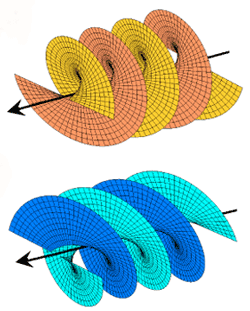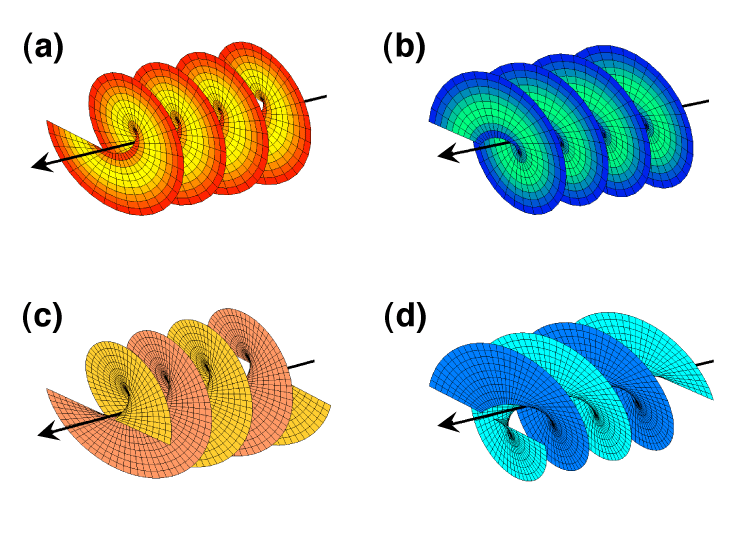Giving Light a New Twist
Physicists have known for a century that a light beam can carry angular as well as linear momentum, but about 15 years ago they learned that this rotation comes in two distinct forms. In the 28 April PRL, researchers describe an optical device that cleanly converts one kind of angular momentum into the other, a demonstration that may ultimately find applications in communication and computing.
Imagine that a wide beam of so-called circularly polarized light is pointed at you. As you look at the beam, the electric field vectors across its face would all appear to sweep around like a set of synchronized clock hands. Now imagine that the clock hands move at the same rate but are out of phase. Freezing the motion, a clock at the top of the beam might point to three o’clock, whereas one to the right of center might point to six o’clock, and so on around the beam [see Focus story from 2001].
In quantum terms, the beam consists of photons, each one imbued with the properties of the beam as a whole. “Synchronized clocks” corresponds to photons with one unit of intrinsic spin, positive or negative according to the sense of the rotation. In the “clocks out-of-phase” case, the photons also possess so-called orbital angular momentum. A single photon can in principle carry any whole-number amount of this rotation, from minus to plus infinity.
Orbital angular momentum is hard to visualize, admits Lorenzo Marrucci of the University of Naples, Italy, but it interacts with matter differently than spin does. If a particle sitting off-axis in a light beam absorbs a photon with orbital angular momentum, it responds by circulating around the beam, not by spinning on its axis.
Marrucci and his colleagues have built a device that reverses the spin of photons while transferring the change of angular momentum into the orbital kind. For example, a photon entering with plus one unit of spin and no orbital momentum will leave with minus one unit of spin and two units of orbital angular momentum, keeping the total constant. Similar arithmetic holds true for any incoming combination of spin and orbital angular momentum.
The design of the converter begins with a standard optical device known as a half-wave plate, made of a material in which light moves at different speeds depending on the direction of its electric field relative to the crystal lattice. Ordinarily, a half-wave plate converts right-handed (“clockwise”) circularly polarized light into left-handed, and vice versa, equivalent to changing the sign of the photon spin. But the Neapolitan physicists created a more sophisticated converter by arranging that one of the crystal axes of the optical material is not aligned the same throughout the device. Instead, its orientation changes with location on the plate. With the right choice of this variation, the device doesn’t absorb spin angular momentum when it reverses a photon’s spin but instead switches it into orbital angular momentum of the outgoing photon.
The Italian work is “very interesting–a lovely paper,” says Johannes Courtial of the University of Glasgow, Scotland. Although applications of the technique are some way off, both he and Marrucci note that orbital angular momentum allows light to carry more bits of information per photon than spin alone, so the ability to manipulate the orbital component could open up new communication methods. In addition, Courtial suggests, controlling the interaction of spin and orbital angular momentum in the same photon might make possible novel kinds of logic operations in future optical or even quantum computers.
–David Lindley
David Lindley is a freelance science writer, now retired. His most recent book is The Dream Universe: How Fundamental Physics Lost Its Way (Penguin Random House, 2020).
More Information
Focus story on orbital angular momentum in light from 2001 Physics Today article “Light’s Orbital Angular Momentum” from 2004 (requires subscription)





